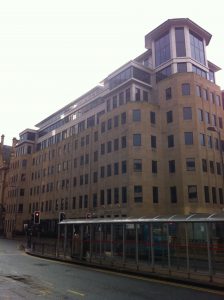Right to Light Matters for Developers
Once Planning Permission has been gained, if a legal right of light exists to neighbouring properties windows then potentially the neighbour(s) could be entitled to an injunction, or compensation, or a combination of both.
 Most developers (usually larger organisations) therefore assess the potential risk early, so that they can consider such risks and make informed decisions before proceeding with the planning process.
Most developers (usually larger organisations) therefore assess the potential risk early, so that they can consider such risks and make informed decisions before proceeding with the planning process.
This usually goes hand in hand with a Daylight and Sunlight Report, often required for validation of the planning application.
The importance of right to light assessments in early stages of development
Rights of light are increasingly becoming an important assessment in early stages of development as the demand for homes spaces increases, the potential of right to light injuries also increases. If we are commissioned to assess such planning related matters, it can often be relatively easy to assess the right of light risk. The process is very straight-forward and only requires a small amount of digital modelling.
Why should you consider right to light assessments early in the planning permission process?
The advantages of assessing risk early include being able to consider making amendments to the scheme before the planning process has run its course. This can then prevent you from gaining planning permission, only to find that you have a right of light infringement case on your hands which requires a redesign, and subsequent re-submission for planning permission.
Insuring against right of light infringements
The other option is that it allows you to consider other options, such as insuring the risk.
Once a planning application is submitted, there is potential for neighbours to object, and if objections feature ‘loss of daylight/sunlight’ or the dreaded words ‘right to light’ then potentially the insurance option may no longer be available.
Contact us
To enquire about a Right to Light Risk Assessment, please complete the form and we’ll be in touch.
If you would like to speak to our team, contact us today and our team will be on hand to help with any enquiries or questions.
Enquire about a Right of Light Risk Assessment

“I worked with Adrian on a planning application for a 11-storey development in Manchester City Centre which had particularly complicated over-shadowing and right-to-light issues, including extant light obstruction notices, which previously I had known nothing about. Adrian was very friendly and forthcoming with advice and operated as an integral member of the design team, helping us to understand the impact of various scales of development and ultimately obtain planning permission for the development by allaying planners concerns.”
Right to Light matters of concern for a Developer

The Potential Costs
The potential costs associated with not fully and adequately assessing the right to light risks early on in the design process are potentially enormous.
At the best, a successful right of light claim might result in a compensation payment to a neighbour. Alternatively, an injunction would necessitate some re-design and probably re-submission for planning permission plus all associated delays and costs.
The very worst case scenario would be an injunction following completion and occupation of a development, such as a court ruling against Highcross in Leeds.
The developer in this case had appealed against the ruling of an injunction against them but, just a few days before the appeal was due to be heard, an out-of-court settlement was agreed. This means that the original court judgement of an injunction remains as unchallenged case law.
Technical Information on Right of Light Matters
Buildings can obtain a legal right to light which then allows an owner to take legal action against a development which would cause a specific loss of light through existing windows of affected rooms.
Most commonly, a right to light will be acquired by anyone who has enjoyed uninterrupted light through an opening (without specific consent, openly and without threat, and without interruption) for more than 20 years. However, there are alternative means of obtaining a legal right of light such as by express grant or implied grant; these alternatives can mean that a new building can immediately have rights of light without having enjoyed light through openings for 20 years.
The Law
A legal right to light is protected in England and Wales under common law, adverse possession or by the Prescription Act 1832. If a development limits the amount of light coming in through a window and if, as a consequence, less than approximately half of the room remains adequately lit, this would constitute a legal injury which would mean that the neighbour to a development would be entitled to compensation or an injunction against the developer.
Right to Light is a specialist area that many Surveyors, Architects and Planning Officers are relatively unaware and, as a consequence, a scheme can pass through the design, drawing and tendering phases without anybody even considering legal rights of light – we are regularly involved with projects where exactly this has happened. It should be noted that, just because a scheme has planning permission does not mean that there might not be legal right to light issues.
The possible remedies for a successful action in respect of a legal right to light claim are an injunction and/or compensation. The fact, though, is that, if it can be demonstrated that there has been a legal injury then, at a minimum, compensation would be payable to the neighbour. There are some notable cases where a Judge has ordered for the partial demolition of a completed development as a result of a successful right of light action.
Right to Light Matters for Architects, Planning Consultants & Project Managers
Are you an architect, or a project manager? Perhaps a planning consultant, advising on scheme viability, getting the client past all those planning hurdles? If so, then unfortunately, if things go wrong, you can count on the finger being pointed at you if a right of light problem arises.
Although often overlooked at all stages from site appraisal through the design process, Rights of Light really do need to be considered all through the process as the implications of not doing so can be significant for all building professionals providing a service to developers.
We often find that we do not become involved with a development project until a dispute has arisen because rights of light have not been adequately considered at an early stage in the progression of the scheme design. However, the implications of getting it wrong regarding a development (of any size including small domestic extensions) can be extremely disruptive and expensive.
Most windows in buildings which have enjoyed light through them for at least 20 years will have obtained a right to light. A development significantly affecting the light through such a window could create a legal injury. The legal remedies for an injury are either compensation or an injunction, with the latter requiring re-design or even demolition of the offending structure.
We often find that assumptions have been made that potentially affected windows do not have a right to light, but this could be an incorrect and risky assumption – such windows might be blocked-up windows, windows to non-habitable rooms or windows with obscure glazing for example. Also, it is worth bearing in mind that 20 years enjoyment now means that windows from the mid-1990s will have probably obtained a legal right of light.
Although, sometimes, schemes may proceed at a risk of a legal Rights of Light challenge from a neighbour, this must be a decision taken by the client/developer based upon a Right to Light risk assessment and not a decision to be taken without any such information or one to be taken by the Architect, Planning Consultant or Project Manager.
Conversely, on the positive side, a Right to Light risk assessment can assist with maximising the site development potential whilst minimising the risk of an injury to the neighbouring buildings.
Case Study

Over the recent years there have been cases which have indicated the legal system’s increasing willingness to award an injunction against a developer rather than simply damages. In the ‘Heaney’ case, dating from 2010, the Court ruled that Highcross had to demolish the top two floors of a Leeds city centre building, which was completed and had tenants, at an estimated cost to them of £2.5 million.
Project Managers
The case of HKRUK II v Heaney in Leeds focussed the minds of those involved with development site acquisitions and Project Managers.
Rights of Light should be on ‘tick-lists’ as one of the many matters to be checked.
Due diligence regarding the purchase of development sites and for lending institutions should ensure that Rights of Light of neighbouring buildings have been fully considered and assessed. An injunction obtained by a neighbour as the result of a Right to Light claim, could make it impossible to construct the development regardless of whether it had previously obtained planning permission and other statutory consents.
Many banks have rights to light on their ‘tick list’ of matters requiring consideration during the appraisal of a development scheme for lending purposes.
Project Managers also need to be fully aware of the risks and should arrange for adequate consideration and appraisal of the risk of Right to Light claims to protect the client’s interests and avoid potential claims against themselves.
We can assist with risk assessments for new developments to re-assure or, otherwise, at least to alert those involved to the potential risks, allowing for fully informed decisions to be made based upon facts.

“I worked with Adrian on a planning application for a 11-storey development in Manchester City Centre which had particularly complicated over-shadowing and right-to-light issues, including extant light obstruction notices, which previously I had known nothing about. Adrian was very friendly and forthcoming with advice and operated as an integral member of the design team, helping us to understand the impact of various scales of development and ultimately obtain planning permission for the development by allaying planners concerns.”
